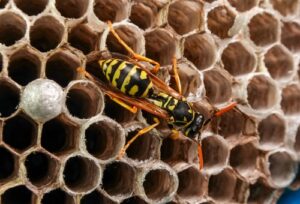Home / Blog / Bees / Honey Bee vs. Yellow Jacket: The Differences Might Surprise You
Honey Bee vs. Yellow Jacket: The Differences Might Surprise You

Scientifically reviewed by Rachel Maldonado
-Published on June 10, 2024
-Updated on October 29, 2025
Honey Bee vs. Yellow Jacket: The Differences Might Surprise You
Just picture it – it’s a warm, sunny afternoon in your garden. You’re tending to your vibrant flowers and lush vegetables when suddenly, you hear a buzzing sound. Your heart skips a beat as you try to figure out if that buzzing friend is a helpful honey bee…or a troublesome yellow jacket.
Unfortunately, both can sting, but knowing the difference is still important, as one poses valuable benefits for your garden. Let’s dive into the world of honey bees and yellow jackets and uncover the surprising differences between them.
Appearance: Spotting the Differences Between Honey Bees and Yellow Jackets

First things first, let’s talk about how to tell these two insects apart just by looking at them.
Honey bees are typically golden-brown with black stripes and are slightly fuzzy. Their bodies are more rounded, and they look a bit like tiny flying teddy bears. This fuzziness isn’t just for show; it helps them collect pollen, which is crucial for their role as pollinators.
On the other hand, yellow jackets are sleek and shiny with bright yellow and black stripes. They’re less hairy than honey bees and have a more elongated body. If you see an insect that looks like it’s wearing a bold, black-and-yellow-striped suit, it’s probably a yellow jacket.
Behavior of Each Species: Friends or Foes?
Honey bees are generally gentle and focused on their work. They’re busy collecting nectar and pollen to take back to their hive. Honey bees are less likely to sting unless they feel threatened or are defending their hive.
When they do sting, they leave their stinger behind, which causes them to die shortly after. This means that honey bees typically sting only as a last resort.
Yellow jackets, however, can be aggressive, especially if you get too close to their nest. They’re scavengers and are attracted to sugary foods and drinks, which is why you often see them at picnics or around trash cans. Unlike honey bees, yellow jackets can sting multiple times without losing their stinger, making them more dangerous if they’re provoked.
Nests: Home Sweet Home
Where these insects build their nests is another clue to identifying them.
Honey bees build their nests (typically made of wax with a characteristic hexagonal pattern) in hives, which can be found in hollow trees, beekeeping boxes, or sometimes in the walls of buildings. Honey bee hives can support thousands of bees working together harmoniously.
Yellow jackets prefer to build their nests in the ground, but they can also nest in wall cavities or attics. Their nests are made of paper-like material, created from chewed wood fibers mixed with their saliva. These nests can house large colonies, often with several thousand yellow jackets buzzing around.
Diet: What’s on the Menu?
The diets of honey bees and yellow jackets also differ significantly.
Honey bees are vegetarians, feeding on nectar and pollen, which they use to make honey. This honey serves as food for their colony, especially during the winter months. As you’re probably already aware, honey bees also play a vital role in pollinating plants.
Yellow jackets are carnivores and scavengers, feeding on insects, meat, and sugary substances. While they do help control pest populations by eating other insects, their aggressive nature and attraction to human food can make them a real nuisance.
Importance: Why They Matter
Both honey bees and yellow jackets play important roles in our ecosystem, but for different reasons.
Without honey bees, many of the foods we love would be in short supply. Fruits, vegetables, nuts, and even coffee rely on pollination. Again, they also produce honey, which is a natural sweetener with numerous health benefits.
Yellow jackets, though often viewed as dangerous nuisances, are also important, as they help control pest populations by feeding on other insects. While this can be beneficial in keeping garden pests at bay, their aggressive nature and tendency to sting make them less welcome guests in our outdoor spaces.
Safety Tips: Coexisting Peacefully With Both Species
Knowing how to coexist with honey bees and yellow jackets can help you enjoy your garden without fear.
Here are a few tips for staying safe around honey bees:
- Stay Calm: Honey bees are less likely to sting if you remain calm and avoid sudden movements.
- Don’t Swat: Swatting at bees can provoke them. Instead, move away slowly if they get too close.
- Avoid Strong Scents: Honey bees are attracted to floral scents and bright colors, so avoid wearing strong perfumes or brightly colored clothing when gardening.
And around yellow jackets:
- Cover Food and Drinks: Yellow jackets are attracted to sugary substances, so keep food and drinks covered when eating outdoors.
- Seal Trash Cans: Make sure trash cans are tightly sealed to prevent yellow jackets from scavenging.
- Call a Professional: If you find a yellow jacket nest near your home, it’s best to call a pest control professional to safely remove it.
Take Time to Get to Know Your Stinging Insects!
Understanding the differences between honey bees and yellow jackets can help you appreciate their roles in our ecosystem and take the necessary precautions to coexist peacefully with them. Though both are important contributors to our environment, honey bees tend to be more gentle and don’t attack quite as aggressively.
If you’re dealing with unwanted yellow jackets or other pests in your home or garden, consider reaching out to Hawx Pest Control Virginia Beach VA. Join our family of satisfied customers and experience the Hawx difference today!
Related Articles
Visit our blog to learn more.
→





